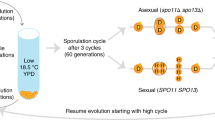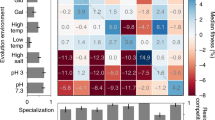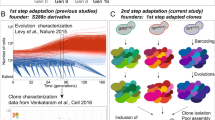Abstract
It is generally accepted from the darwinian theory of evolution that a progressive increase in population adaptation will occur in populations containing genetic variation in fitness, until a stable equilibrium is reached and/or the additive genetic variation is exhausted. However, the theoretical literature of population genetics documents exceptions where mean population fitness may decrease in response to evolutionary changes in gene frequency, due to varying selective coefficients1–4, sexual selection5,6or to epistatic interactions between loci7. Until now, no examples of such exceptions have been documented from fitness estimates in either natural or experimental populations. We present here direct evidence that, as a result of epistatic interactions between adaptive mutations, mean population fitness can decrease in asexual evolving populations of the yeast Saccharomyces cerevisiae.
This is a preview of subscription content, access via your institution
Access options
Subscribe to this journal
Receive 51 print issues and online access
$199.00 per year
only $3.90 per issue
Buy this article
- Purchase on Springer Link
- Instant access to full article PDF
Prices may be subject to local taxes which are calculated during checkout
Similar content being viewed by others
References
Lewontin, R. C. Genetics 43, 419–434 (1958).
Li, C. C. Biometrics 23, 397–484 (1967).
Sacks, J. M. Genetics 56, 705–708 (1967).
MacArthur, R. H. Proc. natn. Acad. Sci. U.S.A. 48, 1893–1897 (1962).
Darwin, C. The Descent of Man and Selection in Relation to Sex 2nd edn (Murray, London, 1874).
Lande, R. Evolution 34, 292–305 (1980).
Moran, P. A. P. Ann. hum. Genet. 27, 383–393 (1964).
Paquin, C. & Adams, J. Nature 302, 495–500 (1983).
Harper, J. L. Population Biology of Plants (Academic, London, 1977).
Kubitschek, H. E. Introduction to Research with Continuous Cultures (Prentice-Hall, New Jersey, 1980).
Cavalli, L. L. & Maccacaro, G. A. Heredity 6, 311–331 (1952).
Malmberg, R. L. Genetics 56, 607–621 (1977).
Hedrick, P., Jain, S. K. & Holden, L. Evol. Biol. 11, 101–184 (1978).
Allard, R. W. Principles of Plant Breeding (Wiley, New York, 1960).
Falconer, D. S. Introduction to Quantitative Genetics 2nd edn (Longman, London, 1981).
Crow, J. F. & Kimura, M. Am. Nat. 99, 439–450 (1965).
Charlesworth, B. Nature 302, 479–480 (1983).
Novick, A. in Perspectives in Marine Biology (ed. Buzzati-Traverso, A. A.) 533–547 (University of California Press, 1960).
Isaacs, J. in Perspectives in Marine Biology (ed. Buzzati-Traverso, A. A.) 545 (University of California Press, 1960).
Holland, J. et al. Science 215, 1577–1585 (1982).
Wright, S. Genetics 16, 97–159 (1931).
Paquin, C. & Adams, J. Curr. Genet. 6, 21–24 (1982).
Helling, R. B., Kinney, T. & Adams, J. J. gen. Microbiol. 123, 129–141 (1981).
Author information
Authors and Affiliations
Rights and permissions
About this article
Cite this article
Paquin, C., Adams, J. Relative fitness can decrease in evolving asexual populations of S. cerevisiae. Nature 306, 368–371 (1983). https://doi.org/10.1038/306368a0
Received:
Accepted:
Issue Date:
DOI: https://doi.org/10.1038/306368a0
This article is cited by
-
Revisiting the Design of the Long-Term Evolution Experiment with Escherichia coli
Journal of Molecular Evolution (2023)
-
Stability analysis of the coexistence equilibrium of a balanced metapopulation model
Scientific Reports (2021)
-
Pattern Formation in a Three-Species Cyclic Competition Model
Bulletin of Mathematical Biology (2021)
-
Rapid turnover of life-cycle-related genes in the brown algae
Genome Biology (2019)
-
Heterogeneous network promotes species coexistence: metapopulation model for rock-paper-scissors game
Scientific Reports (2018)
Comments
By submitting a comment you agree to abide by our Terms and Community Guidelines. If you find something abusive or that does not comply with our terms or guidelines please flag it as inappropriate.



